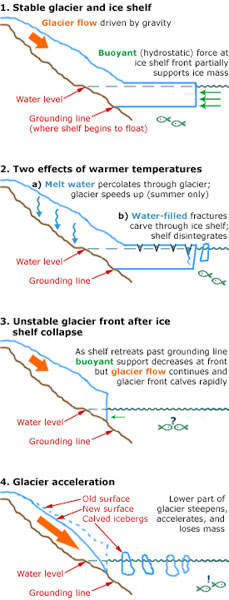Ice sheet
File:Flow of Ice Across Antarctica.ogv
Ice sheets are large masses of glacial ice that cover more than 50,000 square kilometers of land surface. They are the largest type of glacier on Earth, and currently, there are only two major ice sheets in the world: the Antarctic Ice Sheet and the Greenland Ice Sheet. These ice sheets hold the vast majority of the world's fresh water and play a crucial role in the global climate system, influencing ocean currents, weather patterns, and sea level rise.
Formation and Characteristics[edit | edit source]
Ice sheets form in areas where the accumulation of snow exceeds its melt over many years, often millennia. This process, known as accumulation, compacts the snow into firn and eventually into solid ice. The immense weight of the accumulated ice causes it to flow outward and downward under its own weight, shaping the landscape beneath it through processes like erosion and isostatic depression.
The surface of an ice sheet is typically characterized by its smooth, dome-shaped topography, which gradually slopes towards its edges. These edges can break off to form icebergs in a process known as calving, particularly where the ice sheet meets the ocean.
Impact on Global Systems[edit | edit source]
Ice sheets have a profound impact on the Earth's climate and sea levels. They reflect a significant amount of the sun's energy back into space, which helps to regulate the planet's temperature. However, as global temperatures rise, ice sheets are melting at an accelerated rate, contributing to sea level rise and altering global ocean circulation patterns. This melting also affects the albedo effect, where the decrease in reflective ice surfaces leads to increased absorption of solar radiation, further warming the planet.
Research and Observation[edit | edit source]
Scientists study ice sheets through a combination of satellite observations, field measurements, and climate models to understand their dynamics, predict changes, and assess their impact on the global environment. Techniques such as ice core drilling allow researchers to extract samples from deep within an ice sheet, providing valuable information on past climate change, atmospheric composition, and volcanic activity.
Challenges and Future Outlook[edit | edit source]
The future stability of ice sheets is a significant concern for climate scientists and policymakers. Predicting how ice sheets will respond to continued global warming is complex, due to the intricate interplay between atmospheric conditions, ocean temperatures, and ice dynamics. The potential for rapid ice sheet collapse and the resulting rapid sea level rise poses a threat to coastal communities and ecosystems worldwide.
Search WikiMD
Ad.Tired of being Overweight? Try W8MD's physician weight loss program.
Semaglutide (Ozempic / Wegovy and Tirzepatide (Mounjaro / Zepbound) available.
Advertise on WikiMD
|
WikiMD's Wellness Encyclopedia |
| Let Food Be Thy Medicine Medicine Thy Food - Hippocrates |
Translate this page: - East Asian
中文,
日本,
한국어,
South Asian
हिन्दी,
தமிழ்,
తెలుగు,
Urdu,
ಕನ್ನಡ,
Southeast Asian
Indonesian,
Vietnamese,
Thai,
မြန်မာဘာသာ,
বাংলা
European
español,
Deutsch,
français,
Greek,
português do Brasil,
polski,
română,
русский,
Nederlands,
norsk,
svenska,
suomi,
Italian
Middle Eastern & African
عربى,
Turkish,
Persian,
Hebrew,
Afrikaans,
isiZulu,
Kiswahili,
Other
Bulgarian,
Hungarian,
Czech,
Swedish,
മലയാളം,
मराठी,
ਪੰਜਾਬੀ,
ગુજરાતી,
Portuguese,
Ukrainian
Medical Disclaimer: WikiMD is not a substitute for professional medical advice. The information on WikiMD is provided as an information resource only, may be incorrect, outdated or misleading, and is not to be used or relied on for any diagnostic or treatment purposes. Please consult your health care provider before making any healthcare decisions or for guidance about a specific medical condition. WikiMD expressly disclaims responsibility, and shall have no liability, for any damages, loss, injury, or liability whatsoever suffered as a result of your reliance on the information contained in this site. By visiting this site you agree to the foregoing terms and conditions, which may from time to time be changed or supplemented by WikiMD. If you do not agree to the foregoing terms and conditions, you should not enter or use this site. See full disclaimer.
Credits:Most images are courtesy of Wikimedia commons, and templates, categories Wikipedia, licensed under CC BY SA or similar.
Contributors: Prab R. Tumpati, MD




